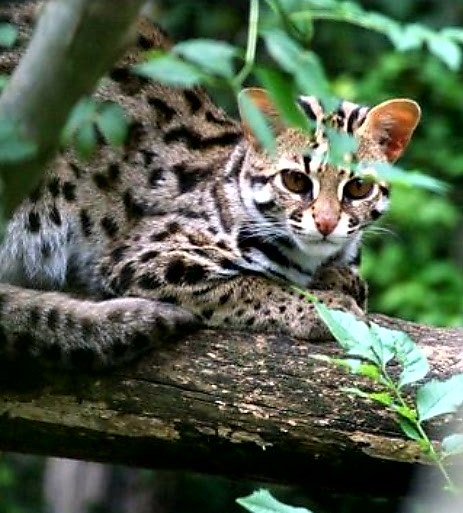The leopard cat (Prionailurus bengalensis) is a small wild cat native to continental South, Southeast and East Asia. Since 2002 it has been listed as Least Concern on the IUCN Red List as it is widely distributed although threatened by habitat loss and hunting in parts of its range.
Historically, the leopard cat of continental Asia was considered the same species as the Sunda leopard cat. As of 2017, the latter is recognized as a distinct species, with the taxonomic name Prionailurus javanensis.
Leopard cat subspecies differ widely in fur color, tail length, skull shape and size of carnassial. Archaeological evidence indicates that the leopard cat was the first cat species domesticated in Neolithic China about 5,000 years ago in Shaanxi and Henan Provinces.
On April 9, a breeder of leopard cats asked the staff of China Biodiversity Conservation and Green Development Foundation (CBCGDF) for help, saying that he has been following CBCGDF for a long time. Asked questions about releasing leopard cats. He breeds five leopard cats, which were originally used for ecological management (to catch rats) to protect the agricultural ecological balance. Now it is not allowed to raise, he would like to ask experts to give reference suggestions, recommend places suitable for the survival of leopard cats, and be able to release them to places where rats need to be controlled.
The breeder conducted an in-depth analysis on the living habits of the leopard cats, the ability to survive in the wild, and the number of populations. At the same time, he also introduced the reasons for breeding leopard cats from the technical aspects of artificial breeding.
At that time, the place where they lived was plagued by rats, and there was no way to manage and control it, especially in winter. They have tried every method, whether it is to catch rats, or poison rats, the effect is not particularly obvious. Because the reproduction ability of rats is too strong. He began to contact the cats that existed in China, especially around the leopard cats breeding area, for ecological management, so that rats face their natural enemies. In the process of understanding, he found that the living environment of small cats is very difficult. The viability of rat is very strong, and the populations of the leopard cat and rat are not equal. Moreover, there are many unknown germs on the rats because their living areas are too messy. No matter what kind of environment, rats can survive, the adaptability is extremely strong, and the immune system is actually much higher than that of humans.
Taking the north and south as an example, the breeder found that the way to eliminate rats is different. In the south, there is no large-scale agricultural production. Poisoning is a way to kill rats. But it is actually more serious in the north, because it is very difficult for the population to live in the wild, especially in winter. There is no way to administer poisoning on a large scale. If there is an outbreak of rat infestation, there is almost no way to cure it. In the three seasons of spring, summer and autumn, most of the wild rat populations live in the wild. But in winter, when food and wild food are scarce, rats will migrate to food areas and run to residents' homes. Settled in places with more grain and larger sites. Even after the spring, the rats will not leave, and will continue to stay there.
Due to the epidemic situation and the introduction of relevant laws, the breeding of leopard cats could not be continued, so he especially sought help from the CBCGDF for a solution to give the leopard cats a new living environment. If there are experts and readers who understand the countermeasures, everyone is welcome to give suggestions and leave a message in the comment area.

(Photo source: Internet)
Original Chinese article:
http://www.cbcgdf.org/NewsShow/4854/12029.html
By / Maggie, Ender Sun
